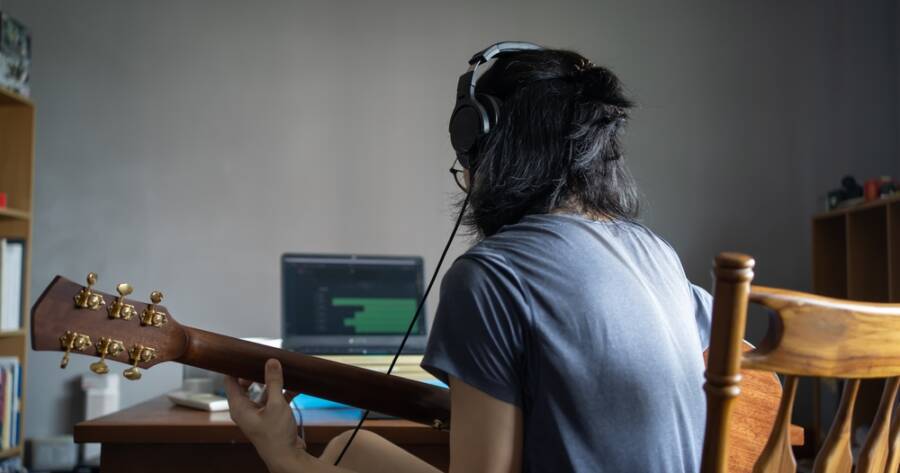What once required a professional studio, a mixing desk, and thousands of dollars in equipment can now happen in a spare bedroom with a laptop and a microphone. Across the United States, a new generation of “bedroom producers” is transforming the sound of popular music. Understand how independent creators can blend accessibility with creativity, redefining what a professional recording can be, all from the comfort of their homes.
The Rise of the Home Studio
Over the past decade, home recording has moved from a niche hobby to the center of modern music production. Affordable software like Ableton Live, Logic Pro, and FL Studio has made high-quality recording tools accessible to anyone with curiosity and patience. Add to that compact audio interfaces, studio monitors, and condenser microphones — and the home setup begins to rival the smaller professional studios of the past.
This shift isn’t only about convenience. It’s about control. Musicians no longer need to rent expensive studio time or rely on traditional gatekeepers. A bedroom producer can write, record, mix, and release a track in a single weekend. That independence has encouraged experimentation, leading to the rich, genre-blending sound that defines today’s charts. From electronic pop to indie rock, and from rap beats to ambient soundscapes, the home studio has become a creative laboratory for artists who prefer to work on their own terms.
The Sound of Freedom
One of the most defining aspects of bedroom production is the freedom it gives creators. Without record label deadlines or studio engineers directing the process, musicians can follow instinct over expectation. Many of today’s breakthrough artists began by making rough demos on home setups, learning through trial and error rather than formal training.
This freedom often leads to unique sonic textures. Slight imperfections — a vocal recorded in a closet, a synth layered too hot, or the background hum of an apartment — become part of the identity of the track. In a way, the bedroom itself becomes an instrument, shaping the warmth and intimacy of the final sound. Listeners, in turn, have come to value that rawness. It feels personal and real, a contrast to the polished, sometimes sterile production of commercial pop from past decades.
Collaboration Without Walls
The internet has turned bedroom producers into a connected global network. Files travel instantly through cloud drives and messaging apps, allowing musicians to collaborate across time zones. A singer in Los Angeles might record a vocal over a beat produced by someone in Atlanta or Berlin. This virtual workflow has become a standard part of the creative process, blurring the line between amateur and professional.
Platforms like SoundCloud and BandLab have accelerated this shift by providing spaces where producers share ideas, beats, and samples openly. Many of today’s major hits trace their roots to a beat uploaded online and discovered by an artist halfway across the world. It’s a kind of digital word-of-mouth, where talent rises through community rather than corporate backing.
The result is a more democratic music landscape — one where innovation often starts not in major studios, but in bedrooms lit by laptop screens.
The New Aesthetic of Homegrown Sound
Bedroom production has also changed how music feels. The home-recorded aesthetic — intimate vocals, experimental effects, minimal gear — has become a legitimate artistic choice rather than a limitation. Artists use the constraints of small spaces and limited tools to find originality.
Genres like bedroom pop, lo-fi hip-hop, and indie electronic owe their distinct textures to this environment. Songs might carry a subtle hiss, a slightly uneven mix, or the sense of being recorded in a lived-in space. What once would have been seen as flaws are now embraced as authentic marks of creativity. Even major labels have started chasing that sound, asking producers to mimic the warmth and immediacy of home recordings.
This trend speaks to a cultural shift: listeners increasingly crave personality over perfection. The bedroom producer, with all their quirks and individuality, embodies that change.
The Changing Role of the Producer
Traditionally, a producer’s job was to guide an artist’s vision in the studio. Now, those roles often overlap. Many modern musicians write, record, produce, and promote their own work. The producer has become the artist — and vice versa.
This has created a new model of independence. A teenager with a laptop can reach the same platforms as a major act, uploading songs to Spotify, Apple Music, or YouTube. The challenge isn’t access anymore; it’s visibility. Success now depends on standing out creatively rather than securing studio time or label funding.
That shift has also inspired older artists to return to self-production, rediscovering the creative freedom that comes from working without external pressure.
A Revolution in Sound and Spirit
The bedroom producer is more than a trend — they’re the foundation of modern music’s evolution. By removing barriers between inspiration and creation, they’ve opened new paths for anyone with a story to tell and a sound to shape.
In the process, they’ve changed what we expect from recorded music. It’s no longer just about clarity or precision; it’s about emotion, connection, and experimentation. Inside countless bedrooms across America, the next wave of musical innovation is being born — one track, one take, and one personal vision at a time.

